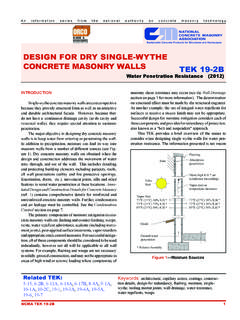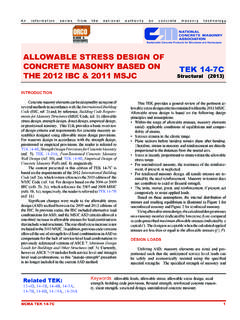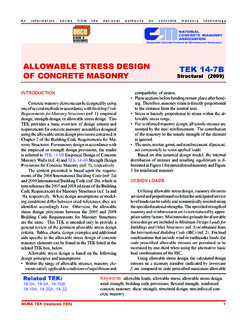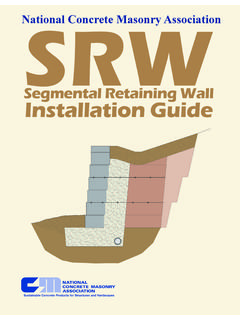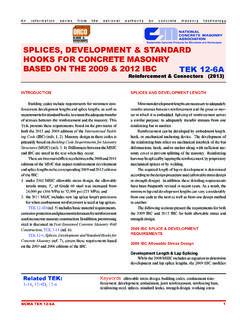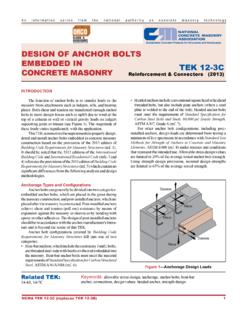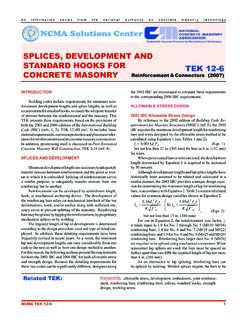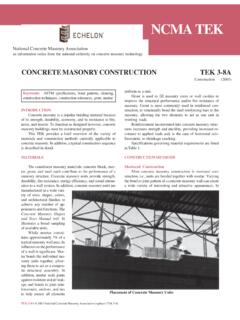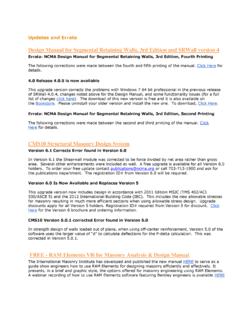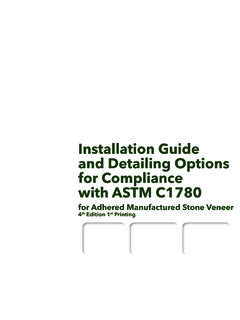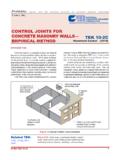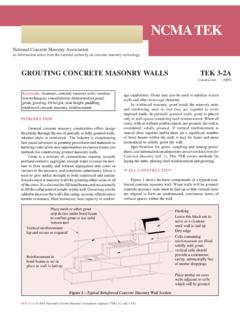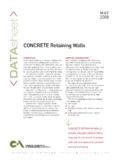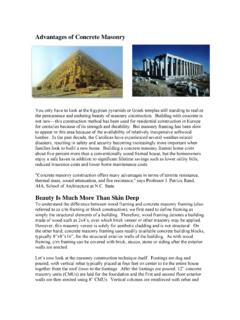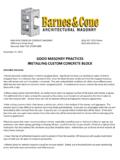Transcription of R-VALUES AND U-FACTORS OF SINGLE WYTHE TEK 6-2C …
1 An information series from the national authority on concrete masonry technologyNCMA TEK 6-2C (replaces TEK 6-2B) 1R-VALUES AND U-FACTORSOF SINGLE WYTHE concrete masonry WALLSTEK 6-2 CEnergy & IAQ (2013)INTRODUCTION SINGLE WYTHE concrete masonry walls are often constructed of hollow units with cores filled with insulation and/or grout. This construction method allows insulation and reinforcement to be used to increase thermal and structural performance, respectively, without increasing the wall thickness. U-FACTORS and R-VALUES are used to estimate heat flow under steady-state conditions (neglecting the effects of thermal mass). These steady-state values can be used in conjunction with factors such as thermal mass, climate, and building orien-tation to estimate a building envelope's thermal performance, typically using software. This TEK lists thermal resistance (R) and thermal transmit-tance (U) values of SINGLE WYTHE walls.
2 Cavity wall R-VALUES are listed in TEK 6-1C, R-VALUES of Multi- WYTHE concrete masonry Walls (ref. 1). The R-VALUES / U-FACTORS listed in this TEK were deter-mined by calculation using the code-recognized series-parallel (also called isothermal planes) calculation method (refs. 2, 3, 4). The method accounts for the thermal bridging (energy loss) that occurs through the webs of concrete masonry units. The method is fully described in TEK 6-1C. Alternate code-approved means of determining R-VALUES of concrete masonry walls include two-dimensional calculations and testing (ref. 2). concrete masonry ENERGY PERFORMANCE Although this TEK presents a compendium of concrete masonry assembly R-VALUES and U-FACTORS , it is important to note that R-VALUES / U-FACTORS alone do not fully describe the thermal performance of a concrete masonry assembly. concrete masonry s thermal performance depends on both its steady-state thermal characteristics (described by R-value or U-factor) as well as its thermal mass (heat capacity) characteristics.
3 The steady state and mass performance are influenced by the size, type, and configuration of masonry Related TEK:2-5B, 6-1C, 6-4B, 6-11A, 6-12C, 6-12D, 6-12 EKeywords: energy codes, insulation, reinforced concrete masonry , R-VALUES , thermal insulation, thermal properties, U-factorsunit, type and location of insulation, finish materials, density of masonry , climate, and building orientation and exposure conditions. Thermal mass describes the ability of materials to store energy. Because of its comparatively high density and spe-cific heat, masonry provides very effective thermal storage. masonry walls retain their temperature long after the heat or air-conditioning has shut off. This, in turn, effectively reduces heating and cooling loads, moderates indoor temperature swings, and shifts heating and cooling loads to off-peak hours. Due to the significant benefits of concrete masonry s in-herent thermal mass, concrete masonry buildings can provide similar energy performance to more heavily insulated light frame buildings.
4 These thermal mass effects have been incorporated into energy code requirements as well as sophisticated computer models. Due to the thermal mass, energy codes and standards such as the International Energy Conservation Code (IECC) (ref. 5) and Energy Efficient Standard for Buildings Except Low-Rise Residential Buildings, ASHRAE Standard (ref. 2), require less insulation in concrete masonry assemblies than equivalent light-frame systems. Although applicable to all climates, the greater benefits of thermal mass tend to be found in warmer climates (lower-numbered Climate Zones). Although the thermal mass and inherent R-value/U-factor of concrete masonry may be enough to meet energy code requirements (particularly in warmer climates), concrete masonry assemblies may require additional insulation, particu-larly when designed under more contemporary building code requirements or to achieve above-code thermal performance.
5 For such conditions, there are many options available for insulating concrete masonry construction. Although in general higher R-VALUES reduce energy flow through a building element, R-VALUES have a diminishing impact on the overall building envelope energy use. In other words, it s important not to automatically equate higher R-value 2 NCMA TEK 6-2 Cwith improved energy efficiency. As an example, consider a two-story elementary school in Bowling Green, Kentucky. If this school is built using SINGLE WYTHE concrete masonry walls with cell insulation only and a resulting wall R-value of 7 ( ), an estimate of the building envelope energy use for this structure is approximately 27,800 Btu/ft2 ( ), as shown in Figure 1. If we increase the R-value of the wall to R14 by adding additional insula-tion while holding the other envelope variables constant, the building envelope energy use drops by only , which is not in proportion to doubling the wall R-value.
6 Figure 1 il-lustrates this trend: as wall R-value increases, it has less and less impact on the building envelope thermal performance. In this example, a wall R-value larger than about R12 no longer has a significant impact on the envelope energy use. At this point, it makes more sense to invest in energy efficiency measures other than wall insulation. When required, concrete masonry can provide assemblies with R-VALUES that exceed code minimums. For overall project economy, however, the industry recommends balancing needs and performance expectations with reasonable insulation CODE COMPLIANCE Compliance with prescriptive energy code requirements can be demonstrated by: the concrete masonry wall by itself or the concrete masonry wall plus a prescribed R-value of added insulation, or the overall U-factor of the wall. The IECC prescriptive R-value table calls for continuous insulation on concrete masonry and other mass walls.
7 This refers to insulation uninterrupted by furring or by the webs of concrete masonry units. Examples of continuous insulation include rigid insulation adhered to the interior of the wall with furring and drywall applied over the insulation, continuous insulation in the cavity of a masonry cavity wall, and exterior insulation and finish systems. These and other insulation op-tions for concrete masonry assemblies are discussed in TEK 6-11A, Insulating concrete masonry Walls (ref. 6). If the concrete masonry assembly will not include con-tinuous insulation, there are several other options to comply with the IECC requirements concrete masonry assemblies are not required to have continuous insulation in order to meet the IECC, regardless of climate zone. Other compliance methods include: prescriptive U-factor tables, and computer programs which may require U-FACTORS and heat capacity (a property used to indicate the amount of thermal mass) to be input for concrete masonry walls.
8 See TEK 6-4B, Energy Code Compliance Using COMcheck, (ref. 7) for more detailed information. Another compliance method, the energy cost budget method, incorporates sophisticated modeling to estimate a building's annual energy cost. A more complete discussion of concrete masonry IECC compliance can be found in TEKs 6-12C (for the 2006 edition of the IECC), 6-12D (for the 2009 IECC)and 6-12E (for the 2012 IECC) (refs. 8, 9, 10). concrete masonry UNIT CONFIGURATIONS Revisions in 2011 to ASTM C90 Standard Specifica-tion for Loadbearing concrete masonry Units (ref. 11) have significantly reduced the minimum amount of web material required for CMU. Values in this TEK are based on concrete masonry units with three webs, with each web being the full height of the unit, and having a minimum thickness as provided in historical versions of ASTM C90 (see Table 1). The changes in C90, however, allow a much wider range of web con-figurations, with corresponding changes in R-VALUES and U-FACTORS (because the webs of a CMU act as thermal bridges, reducing the CMU web area increases the R-value of the corresponding concrete masonry assembly).
9 A full discussion of these changes can be found in TEK 2-5B, New concrete masonry Unit Configura-tions Under ASTM C90 (ref. 12). The Thermal Catalog of concrete masonry Assemblies (ref. 13) lists R-VALUES and U-FACTORS of traditional units, as included here, as well as wall assem-blies with smaller web areas, as now allowed by ASTM C90. The additional wall assemblies are based on: CMU having two full-height 3/4 in. (19 mm) thick webs, and a hybrid system of CMU, intended to maximize thermal efficiency. The Figure 1 Diminishing Returns of Added Wall InsulationNCMA TEK 6-2C 3hybrid system uses the two-web units described above for areas requiring a grouted cell, and a one-web unit where grout confinement is not required. Although the R-VALUES / U-FACTORS in Table 2 are based on typical 8-in. (203-mm) high concrete masonry units, 4-in. (102-mm) high units (commonly called half-high units) are also widely available, and other heights may be available in some markets.
10 Because the wall R-VALUES vary so little with different unit heights, the values in Table 2 can be applied to units with heights other than 8 in. (203 mm).U-FACTOR AND R-VALUE TABLES TRADITIONAL THREE-WEB UNITS Table 2 lists calculated U-FACTORS and R-VALUES of various thicknesses of concrete masonry walls, for concrete densities of 85 to 135 lb/ft3 (1,362 to 2,163 kg/m3), with various core fills. Table 3 shows the approximate percentage of grouted and ungrouted wall area for different vertical and horizontal grout spacings, which can be used to determine R-VALUES of partially grouted walls (see following section). In addition to the core insulations listed across the top of Table 2, polystyrene inserts are available which fit in the cores of concrete masonry units. Inserts are available in many shapes and sizes to provide a range of insulating values and accom-modate various construction conditions. Specially-designed concrete masonry units may incorporate reduced-height webs to accommodate inserts.
